 The pearl is the oldest known collectable gem in the world. A pearl measuring a quarter inch in diameter, takes up to 25 years to form inside the clamshell. Clams serve two main purposes on earth: they are a source of purification and they are also a food source.
The pearl is the oldest known collectable gem in the world. A pearl measuring a quarter inch in diameter, takes up to 25 years to form inside the clamshell. Clams serve two main purposes on earth: they are a source of purification and they are also a food source.
These are just a few of the interesting facts Ric Ladonski of Niles, Michigan shared during his presentation about freshwater pearls Tuesday afternoon at Miller’s Assisted Living. He also burst the bubble surrounding the myth that each pearl is formed because of a grain of sand irritating the inside lining of a clam.
“Any foreign products or particle that gets inside a clam can become a pearl,” stated Ladonski. “Any impurity inside the clam signals ‘biological warfare”; and the clam must coat the impurity to protect it from dying. Not every clam has a pearl in it!”
A question from the audience concerning the difference between oysters and clams brought to light another interesting fact about pearls.
“Oysters are from saltwater areas,” explained Ladonski. “And clams are from freshwater rivers and lakes. Ocean pearls are more costly because of the difficulty of harvesting them.”
During the hour long program, Ladonski told about the history of the freshwater pearl industry he has researched in the Michiana area. The clams were harvested for the purpose of making pearl buttons. At one time there were over two hundred button factories in the United States. In his research he discovered seven of those factories were in Mishawaka, In.; St. Joseph, Niles, and Paw Paw, Michigan.
Ladonski gave the Miller’s residents and visitors a lesson on how the pearl buttons were manufactured. He began by explaining the life cycle of the clam. He then explained about the harvesting, prepping the shells for cutting out the button blanks using a lathe and cylindrical saw. The blanks were then sorted by size, tumbled in a churn with water to smooth the sharp edges and dried. The blanks were then sent to “formers” who rounded the edges and cut the thread depression slot and drilled two or four thread holes. The buttons were then polished and sorted and sewn on cards for distribution.
Ladonski is a retired machine tool teacher in the Niles and Brandywine, Michigan school districts. He was drawn to finding out more about the industry when he realized some shells he found had holes in them. The holes showed evidence of machining.
Ladonski began his research and freshwater pearl collection in 2000. He enjoys sharing his knowledge and admits he never tires of learning new facts about his hobby.
Photo: Katie Kubley of Miller’s Assisted Living observes the differences in the texture of a oyster (salt water) shell and a clam (fresh water) shell during Ric Ladonski’s presentation.
Provided














